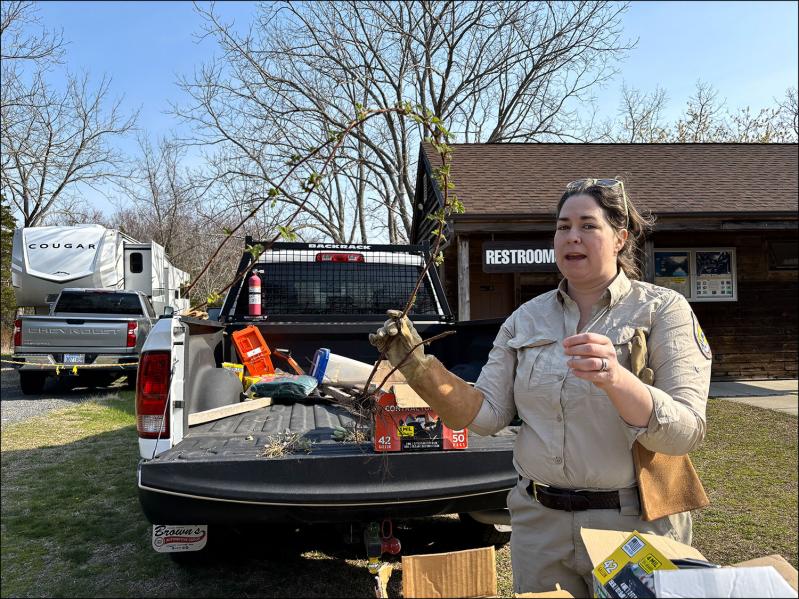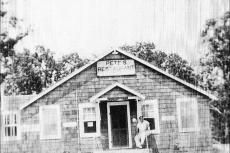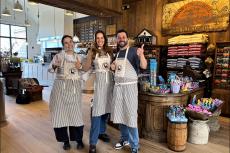Most people go to the Elizabeth Morton Wildlife Refuge in Noyac, part of the National Wildlife Refuge system, to feed the birds. There, black-capped chickadees and tufted titmice, for better or worse, have been trained to accept seeds from human hands. On Saturday, however, 15 people showed up instead to rip invasive plants out of the ground.
It was a joint effort hosted by the United States Fish and Wildlife Service and the Southampton Trails Preservation Society, and facilitated by Cole Environmental Services of East Quogue.
The invasive plant problem at the refuge is extreme, complex, and not going away soon. In fact, it’s so bad that certain invasives are serving as “scaffolding” on which other invasives are climbing and growing.
This is obvious even at the parking lot, where four invasive plants account for the bulk of the vegetation. Garlic mustard forms a leaf-level understory pierced by stalks of wineberry and multiflora rose. Over it all, barbed strings of last year’s mile-a-minute weed encase it in an ever-expanding net.

According to the Long Island Invasive Species Management website, an invasive species is “a non-native species able to establish on many sites, grow quickly, and spread to the point of disrupting communities or ecosystems.”
Terra Willi, a coastal ecologist with the Fish and Wildlife Service, led the volunteer group in tackling a tiny area and focused their efforts on only two species: wineberry and garlic mustard. She said nearly 100 non-native species have been found at the Morton refuge, though not all of them are invasive.
“Our goal is to try to reduce their spread farther into the refuge. They’re really prevalent along the trails,” she told the assembled group. Humans inadvertently track seeds on their shoes, while wildlife poop them everywhere.
Ms. Willi quickly profiled each species. Wineberry is native to eastern Asia. It grows “canes” that are often finger-thick and wobbly and, after reaching a height, loop back toward the ground where they can reroot. The stalks are wine-colored (hence the name) because they are covered in fine red hair interspersed with some serious thorns. Looping thickets of the invasive form become impassable and dense, crowding out native species.
She handed out thick gloves and cautioned the wineberry group to pull the plants slowly, as any part of the root that remained could eventually re-emerge. “It’s going to take years for us to manage it,” she said. “If you leave even the tiniest piece of root it’ll grow back.” It was sort of like a horror movie. You think the malevolent force is gone, but nope, here it is again to murder an entire sorority.
Perhaps because it’s low to the ground, garlic mustard isn’t as obvious a problem at the refuge. If left to spread, however, it can form dense carpets, again, to the detriment of native plant species, Ms. Willi said. That’s important because our insects and birds are reliant on native species for their survival. Non-native plant species aren’t as useful to our local wildlife.
Invasives have many noxious characteristics. Some, like autumn olive and bamboo, will take over huge swaths of real estate. Others, like Japanese barberry and garlic mustard, change the chemical composition of surrounding soil, making it inhospitable to native species. Tree of heaven, or ailanthus, grows rampantly and has the added evil bonus of hosting an invasive insect, the spotted lanternfly. Others, like swallowwort, attract our native insects, in this case the beloved monarch butterfly, but are a dead-end host. “The larva hatch as caterpillars but they’re not adapted to eat it,” Ms. Willi said. “They starve.”
“I used to do this in the woods around my house, but now they’re gone,” Becky Jones of Noyac said as she carried an uprooted wineberry cane near the refuge’s entrance. She described the “spec house” rising next to her home, and the clearing in her neighborhood — a common theme on the East End in 2025, and a different sort of invasion altogether.
Taking the thorny cane from her was Hudson McDermott, 12, her neighbor. “Three years ago, I was in the woods cutting down vines and he came out and asked me if I needed help,” Ms. Jones said.
“Our neighborhood is overdeveloped now, so there’s not much for me to help her with there,” the boy said with a shrug.
After three hours, the volunteers slowly started to disengage. “I just try to get out, burn some calories, and help the environment,” said Liz Karpin of Hampton Bays.
Doug Busby, a volunteer with the National Wildlife Refuge, used duct tape to seal the thick black plastic contractor’s bags, now full of wineberry canes. “These are going to Wertheim,” he said, referring to the Wertheim National Wildlife Refuge in Shirley. “Terra will put them under a tarp and kill them. They’ll dry and bake in the sun. Once they’re dead and there’s no chance of rerooting, they’ll dispose of them.”
Ms. Willi pointed to an area that was managed for wineberry five years ago. It was still relatively clear, she said, as she sprinkled a native seed mix over the newly cleared area by the entrance.
“The invasive removals are extremely important,” Kate Rummel, a principal with Cole Environmental Services, wrote in an email. “Not only to tackle invasives, but to help educate the public as to why they’re problematic.”




